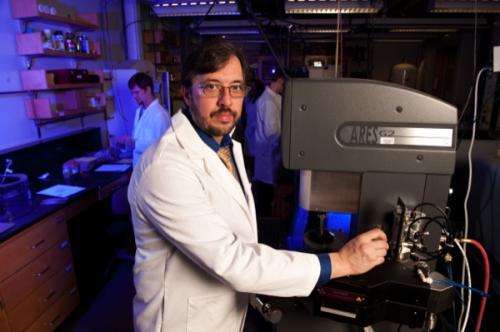Spontaneous science: Researchers report spontaneous case of vesicle formation

(Phys.org) —A University of Delaware research group has reported a spontaneous case of vesicle formation in the Journal of American Chemistry. The discovery was recently highlighted on the journal cover and the significance discussed in a Spotlight article.
Vesicles are fluid filled membranes or sacs useful for their ability to contain things. In the body, for example, they can be used in drug delivery, where a drug is placed in a vesicle and then self-directed to a particular location.
In nature, however, few reports of spontaneous vesicle formation exist.
"That's what makes this discovery special," explains Norman J. Wagner, Alvin B. and Julia O. Stiles Professor of Chemical and Biomolecular Engineering.
Working in the laboratory, Wagner's research team was experimenting with surfactants and ionic liquids, a special class of materials that include organic salts that are liquid, not solid, at room temperature. Ionic liquids operate over a large temperature range and don't evaporate readily. According to Wagner, they are thought to be an avenue toward green chemistry.
In another application, Wagner is also working with NASA scientists and engineers in using ionic liquids to protect astronauts and spacecraft in the extreme environments of near earth orbit and extraterrestrial habitation.
The team was working to understand how to control nanostructured materials in ionic liquids as a replacement solution for cases where water cannot or should not be used.
The discovery of vesicles, however, was unexpected.
"We weren't looking for vesicles, rather we hoped to see sponge phases (three dimensional networked structures resembling sponges), lamellar phases (layered structures that look like a deck of cards) or rod formations," he said.
The team, which includes an industrial scientist, graduate student and undergraduate researcher, conducted extensive experimentation over a two-year period to validate that the vesicles were occurred naturally, and were not the result of processing, handling or impurities.
Now, the team will work to determine how this discovery can be leveraged from a scientific perspective.
"As molecular engineers, part of our goal is to apply this knowledge to control and harness the discovery to design new nanostructures," he said.
More information: pubs.acs.org/doi/abs/10.1021/ja3117262
Provided by University of Delaware
















